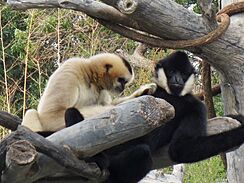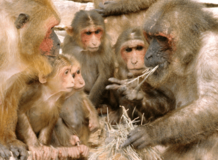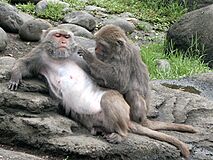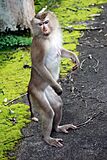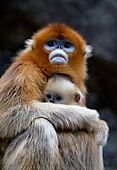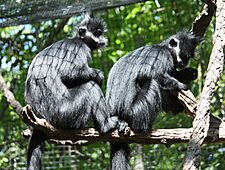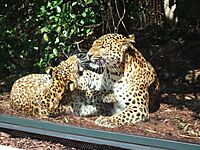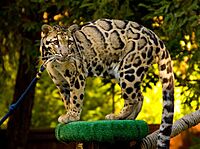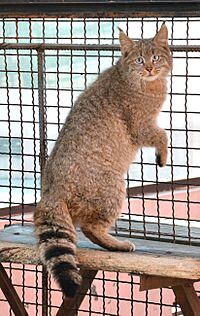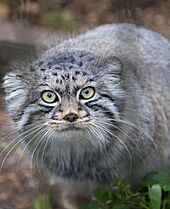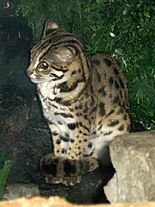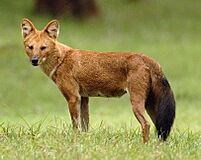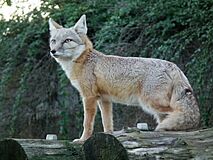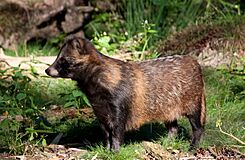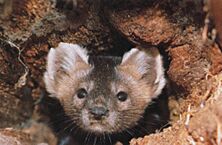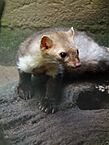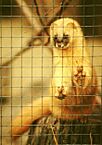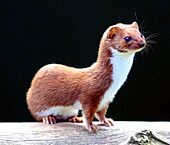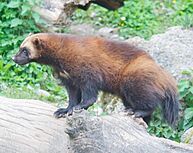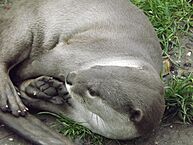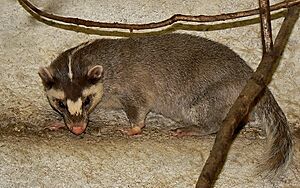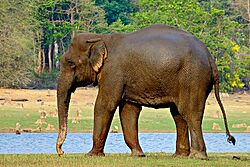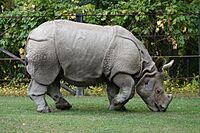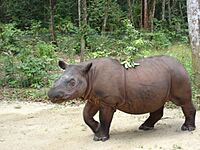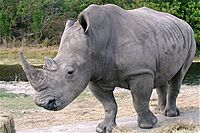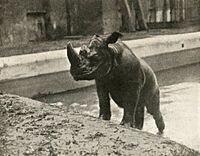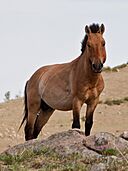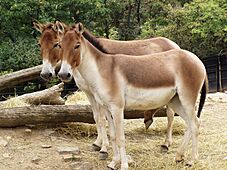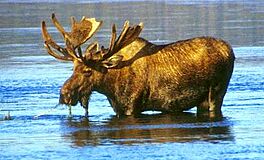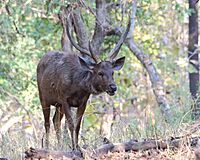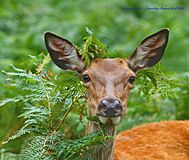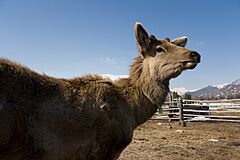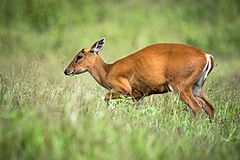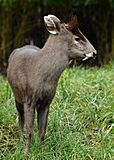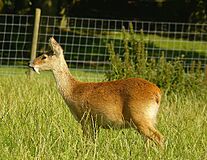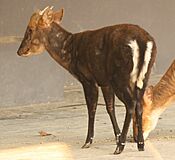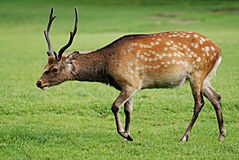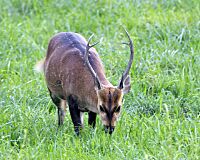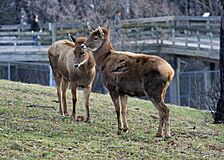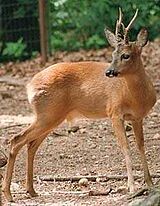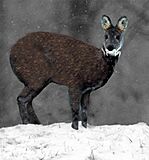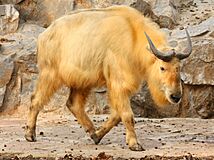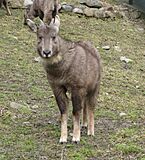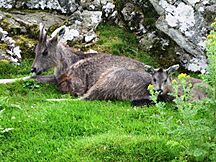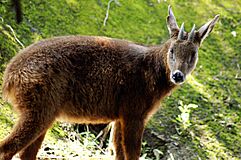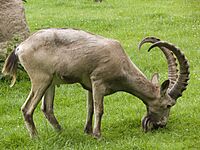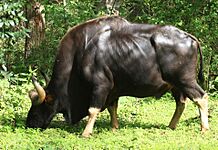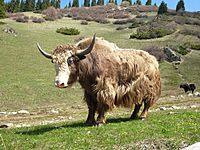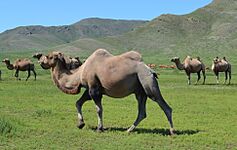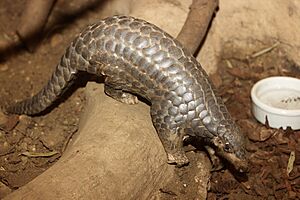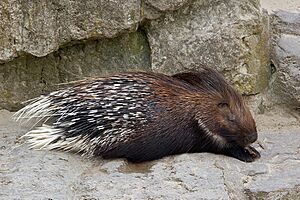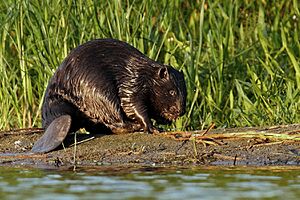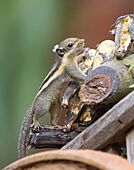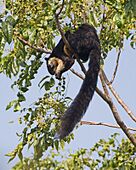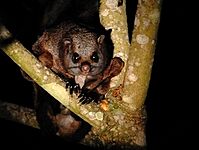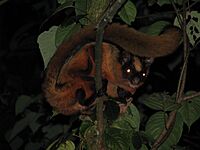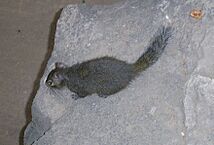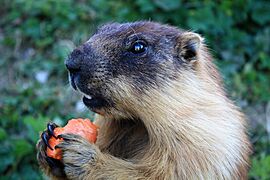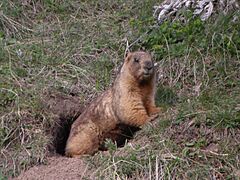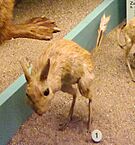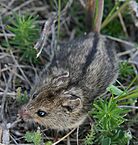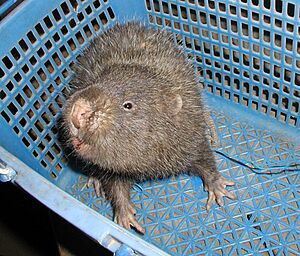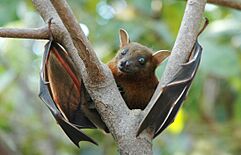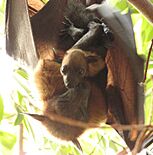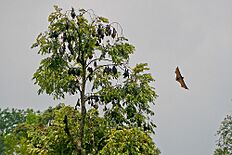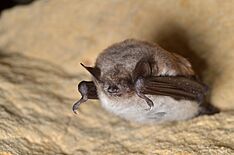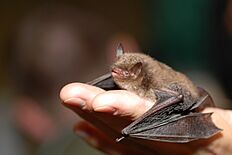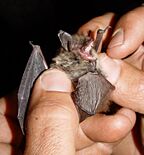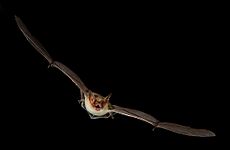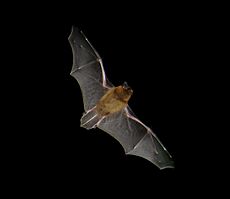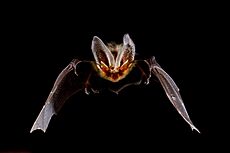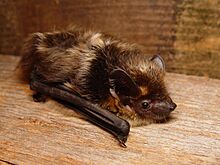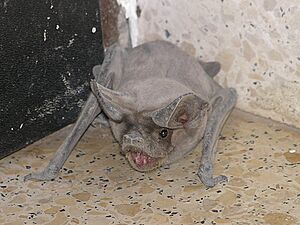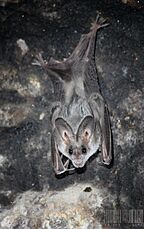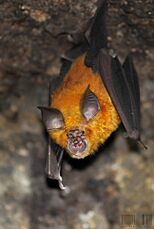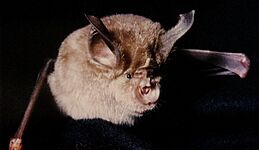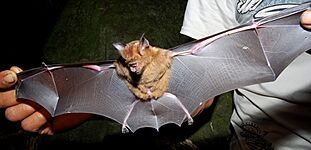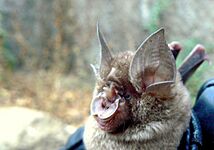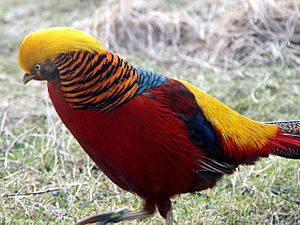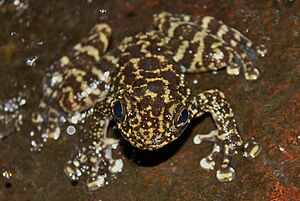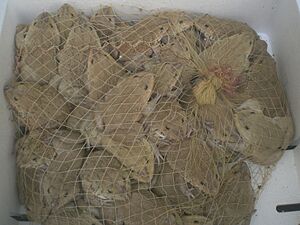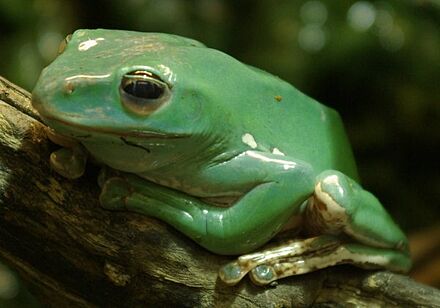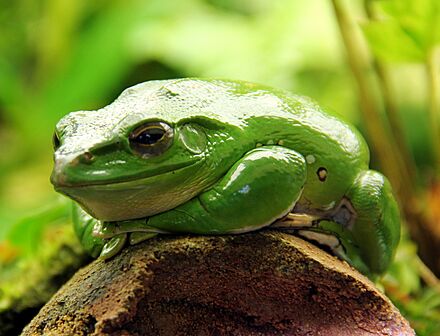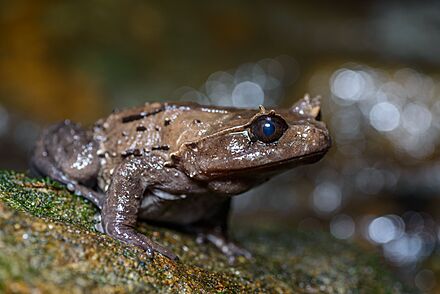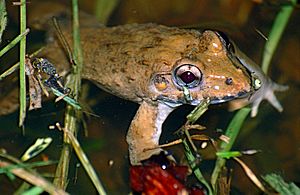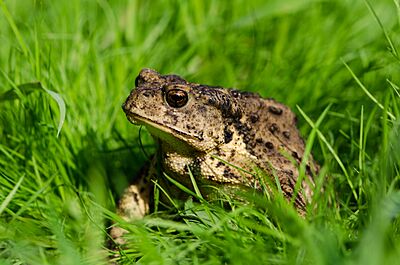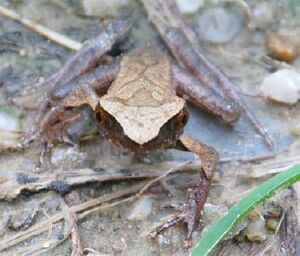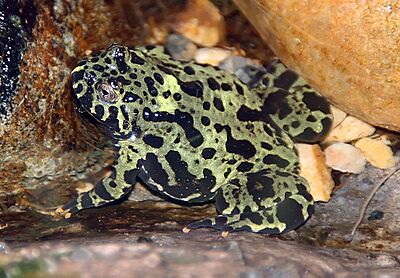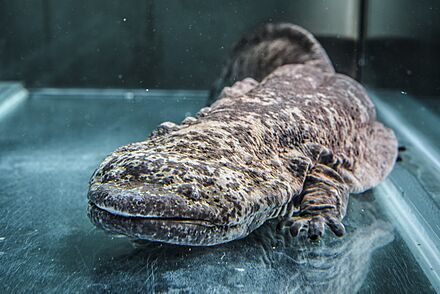Wildlife of China facts for kids
China is a huge country with many different landscapes, from tall mountains to warm coasts. Because of this, it's home to an amazing variety of animals! It's one of the 17 "megadiverse countries" in the world, meaning it has a super high number of different species.
Scientists have counted 7,516 kinds of vertebrates in China. This includes 4,936 types of fish, 1,269 birds, 562 mammals, 403 reptiles, and 346 amphibians. China ranks third globally for mammals and seventh for reptiles and amphibians.
Many animals found in China live nowhere else on Earth. These are called endemic species. The most famous example is the giant panda, which only lives in China. About one-sixth of all mammal species and two-thirds of all amphibian species in China are unique to the country!
Sadly, China has the world's largest human population, and this puts a lot of pressure on wildlife. Things like destroying animal homes, pollution, and poaching (illegal hunting) for food, fur, or ingredients for traditional Chinese medicine threaten many species. At least 840 species are in danger. To help, China has created over 2,349 nature reserves, which cover about 15% of the country's land. These areas help protect endangered animals and their habitats.
Mammals
Mammals are warm-blooded animals that have fur or hair and feed their babies milk. China has many different kinds of mammals, from tiny mice to giant pandas.
Primates
China is home to 21 types of primates, which include gibbons, macaques, and snub-nosed monkeys. Most of China's primates are in danger of disappearing. Monkeys and apes, especially gibbons and macaques, are often seen in Chinese stories, art, and traditions. The monkey is even one of the 12 animals in the Chinese zodiac.
The only apes that live naturally in China are gibbons. These tree-dwelling animals use their long arms to swing through branches. You can often hear gibbons by their loud calls; mating pairs sometimes sing together!
The Hainan black crested gibbon is one of the rarest apes in the world. Fewer than 30 of them live in the Hainan Bawangling National Nature Reserve on Hainan Island. Male Hainan black crested gibbons are black, while females are golden brown. The eastern black crested gibbon is also very rare, with only about 20 in China. Sadly, 99% of their natural home in China has been lost.
The black crested gibbon lives in a larger area of southwestern China. The Yunnan lar gibbon, a type of lar or white-handed gibbon, might already be gone from China. It was last seen by scientists in 1988.
Northern white-cheeked gibbons are almost gone from the wild in southern Yunnan. Local people sometimes hunt them for good luck charms or for their bones. All gibbons in China are highly protected by law.
Macaques are the most common primates in China. They have big cheeks to store food and live in large groups. Rhesus macaques live all over China, from the north to Hainan. Tibetan macaques are often seen at tourist spots like Mount Emei. Stump-tailed macaques have bright red faces and live across southern China. The Formosan rock macaque lives only in Taiwan.
Even though macaques are protected, their numbers have dropped a lot. From 1998 to 2004, the number of rhesus macaques in China fell from 254,000 to about 77,000. Tibetan macaque numbers also dropped by 83% in the same time.
Snub-nosed monkeys are named for their very flat faces, with almost no nose! Four of the five species in the world live in China, and three of these are found nowhere else. They all live in mountain forests high up. The golden snub-nosed monkey is the most well-known. The gray snub-nosed monkey is the most endangered, with only about 700 left.
Other monkeys in China include the François' langur and capped langur. These are often called "leaf monkeys" because they eat leaves. They have shorter arms, longer legs, and long tails. All of these species are endangered.
Lorises are different from apes and monkeys. They have huge eyes, tiny ears, and live in trees. They are active at night. The pygmy slow loris and Bengal slow loris are both found in southern China and are highly protected.
Carnivores
Carnivores are meat-eating mammals. This group includes many different animals, from tiny weasels to huge tigers.
Cats
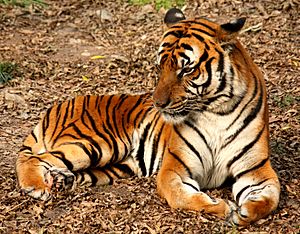
China is home to several big cat species, including the tiger, leopard, snow leopard, and clouded leopard.
The tiger is an important animal in Chinese culture and history. Tiger bones and fur have been used in traditional Chinese medicine and for decoration. This makes tigers very vulnerable to poaching and losing their homes. All four tiger types that once lived in China are now critically endangered and live in nature reserves.
The Siberian tiger lives in the northeast, near Russia. The Caspian tiger is now extinct in China. The South China tiger is a unique type found only in China, mostly in mountain areas. A few Indochinese tigers also live in Yunnan.
Three types of leopard are found in China. The Amur leopard lives in northern China, near Russia. Leopards have been seen crossing between China, Russia, and North Korea. The snow leopard lives in the high mountains of the Himalayas and Tibetan Plateau in western China.
The clouded leopard lives in forest regions south of the Yangtze River. The Chinese mountain cat is found only in China, on the edge of the Tibetan Plateau. It was first photographed by a camera trap in 2007.
Other wild cats in China include the Eurasian lynx in the northeast and Pallas's cat in high-altitude areas. The Asiatic wildcat lives in western China but is rapidly declining due to hunting and habitat loss. The Asian golden cat and leopard cat are found in central and southern China.
Canines
The Canidae family includes dogs, wolfes, dholes, and various foxes. Two types of wolf live in China: the Eurasian wolf and the Tibetan wolf.
Some of the earliest dogs may have been tamed in East Asia. Chinese dog breeds like the shar-pei and chow chow are very old.
Dholes are wild dogs now found in only six provinces in China. The red fox lives almost everywhere in China. The corsac fox is in the northeast, and the Tibetan sand fox lives on the Tibetan Plateau. The raccoon dog, which can climb trees, is native to eastern and northeastern China.
Pandas, bears
The giant panda is probably China's most famous animal. It lives in mountain valleys in Sichuan, Gansu, and Shaanxi provinces. Only about 1,600 pandas live in the wild, with most of them in Sichuan. Another 300 live in zoos and breeding centers. Pandas are rare and hard to find. Even though they are carnivores, their diet is over 90% bamboo! Their black and white fur helps them hide in the dense forests. Adult pandas have no natural predators.
Giant pandas are hard to breed because they have short mating periods and usually only have one or two cubs a year. A panda cub is the smallest baby, compared to its parents' size, of any placental mammal. The giant panda is considered a national treasure and is a protected endangered species. Since the 1970s, China has sent or lent pandas to foreign zoos as a sign of friendship.
Other bears in China include the Asiatic black bear and the brown bear, found across much of the country. The sun bear lives in Yunnan. Some bears, especially black bears, are raised in captivity for their bile, which is used in traditional Chinese medicine.
The red panda is not a bear! It's more like a raccoon and belongs to its own family. Red pandas are found in Sichuan and Yunnan.
Otter, badger, weasel, marten, wolverine
The largest family of meat-eating mammals includes otters, badgers, weasels, martens, and wolverines. All of these animals are found in China. They are all furry with short, rounded ears, but they vary a lot in size and where they live.
The sable, a type of marten, is valued for its beautiful fur. It lives in northeastern China and northern Xinjiang. The beech marten and yellow-throated marten are related to the sable.
The Siberian weasel is the most common weasel in China. It's known for sometimes stealing chickens but also helps control rodent populations. Hair from its tail is used to make brushes for Chinese calligraphy. Other weasel species include the least weasel and stoat in the north, and the mountain weasel in the west.
The wolverine is called "sable bear" in Chinese because it's bigger than a sable but smaller than a bear. Wolverines are fierce animals that will even fight bears and wolves for food! They are very rare in China, with only about 200 left.
The European otter is found across much of China. The Oriental small-clawed otter is the smallest otter and lives in southern China. Otter fur is also used for clothing. Sables and wolverines are highly protected species.
Badgers have white stripes on their faces. The Asian badger lives throughout China. The hog badger has a snout like a pig. Ferret-badgers are the smallest badgers, and two species live in China: the Chinese ferret-badger and the Burmese ferret-badger.
Seals, sea lions
Pinnipeds are also carnivores that live in the sea. They include true seals and eared seals (like sea lions). True seals don't have outside ears and can't move their back flippers under their bodies to crawl. Eared seals have visible ears and can "walk" on land.
True seals in China include the bearded seal, ringed seal, and spotted seal. The spotted seal is the only seal that breeds in China, mainly in the Bohai Gulf. These seals have been hunted for their fur, and their homes are damaged by human activities. All seals are protected animals. Sea lions have even higher protection.
The northern fur seal and the large Steller sea lion are sometimes seen off China's coasts.
Whales, dolphins, porpoises
China has many types of cetaceans (whales, dolphins, and porpoises) that live in both freshwater and the sea. The nearly extinct baiji dolphin and Chinese white dolphin are highly protected.
In ancient China, whales were sometimes confused with sharks. During the Qing dynasty, people learned more about whales as whaling industries grew. The People's Republic of China banned whaling in 1981.
Recently, more minke whales and smaller dolphins have been seen in the Yellow Sea, thanks to cleaner water and better fishing rules. This has led to ideas for whale watching tours.
Baiji
The baiji dolphin, also called the Goddess of the Yangtze, used to live throughout the Yangtze River. In the 1950s, there were about 6,000 baiji, but their numbers dropped quickly. By 2000, there were fewer than a dozen.
The Yangtze River is one of the most crowded areas in China, with lots of ships. Water pollution, noise, fishing, and large ship propellers were major threats to the baiji. Dams also blocked their access to parts of the river.
In 2006, a survey found no baiji dolphins, and the species was declared functionally extinct. This means that even if a few survived, there weren't enough to reproduce. The last confirmed sighting by a scientist was in 2004. Nature reserves were set up to protect the baiji, but it was too late.
Finless porpoise
At least two types of finless porpoise live in China's coastal waters. A freshwater type lives in the Yangtze, Gan, and Xiang Rivers. Unlike dolphins, they don't have a dorsal fin (the fin on their back). The freshwater porpoise faces the same dangers as the baiji. In April 2012, twelve were found dead in Dongting Lake.
As of 2012, there were about 40 finless porpoises in the Tian-e-Zhou Oxbow Nature Reserve. The freshwater finless porpoise is even rarer than the giant panda.
Oceanic dolphins


The Chinese white dolphin lives in the waters off southern China, including Hong Kong. It's a symbol of Hong Kong, and special areas have been created to protect it.
Other oceanic dolphins include the Pacific white-sided dolphin, spinner, striped dolphin, and common bottlenose dolphin.
Whales

Whales used to be common in Chinese and Taiwanese waters, especially in winter and spring when they came to breed. In ancient times, some coastal people in China respected whales as "Kings of the Sea."
Baleen whales found off China's coast include the blue whale (the world's largest animal), as well as fin whales and humpback whales. Historically, there was a group of fin whales that lived in the Yellow and Bohai Seas.
Critically endangered North Pacific right whales and western gray whales were seen in the East China Sea and Yellow Sea before the 1970s. Most large whales in East Asia were hunted to near extinction by whaling industries.
Toothed whales, not including dolphins, include the sperm whale, orca (killer whale), and pilot whales. Sperm whales are still common off the east coast of Taiwan.
Large whales are now very rare off China's coasts. However, whale watching tours are popular in Taiwan, offering chances to see these amazing creatures.
Dugongs

Dugongs are marine mammals that eat only plants like seagrass. They are related to manatees and are the only type of sirenian found in Asian waters. In China, dugongs live along the coasts of Guangxi and Hainan. The Hepu Dugong National Nature Reserve was created in 1992 to protect them.
Dugongs are considered regionally extinct in Taiwan. They are a highly protected species. They were hunted for their meat in the past. Today, they are threatened by the loss of seagrass beds due to coastal development.
Elephant
Asian elephants once lived in many parts of China, but now they are only found in southern Yunnan. In recent years, the demand for ivory has led to more elephant poaching worldwide. However, thanks to strict laws and feeding programs, the number of elephants in China has doubled to nearly 300 between 1994 and 2014.
Odd-toed ungulates
This group includes animals like horses and rhinos, which have an odd number of toes on each foot.
Rhino
Old records and artwork show that three types of Asian rhinoceros once lived in China: the Indian rhinoceros, Javan rhinoceros, and Sumatran rhinoceros. About 3,000 years ago, rhinos lived as far north as Inner Mongolia.
Demand for rhino horns for traditional Chinese medicine led to their extinction in China. The last Sumatran rhino was killed in 1916, the last Indian rhino in 1920, and the last Javan rhino in 1922.
In 2010, nine southern white rhinoceros were brought from South Africa to Yunnan. In 2014, two of these African rhinos began to be released into a forest park where Asian rhinos once lived.
Horses and wild asses
The Przewalski's horse is the only type of wild horse that has never been tamed. It used to live in northwestern China but became extinct there in 1957. In the 1980s, horses from Europe were brought back to China.
Other odd-toed ungulates in China are the Mongolian wild ass and the Tibetan wild ass (kiang). Both are highly protected species.
Even-toed ungulates
This group includes animals like deer, antelopes, and cattle, which have an even number of toes on each foot.
Deer
China has many different kinds of true deer and their relatives, the musk deer. The largest deer, the elk (known as moose in North America), lives in the northeast. It can be 2 meters tall and weigh 700 kg. In contrast, the tiny lesser mouse-deer of Yunnan is only 45 cm tall and weighs 2 kg, not much bigger than a rabbit!
The sambar deer, the third largest deer, lives throughout southern China. It's sometimes called "water deer" because it lives near water. However, it's not the same as the Chinese water deer, a smaller deer that lives in the Yangtze Delta region. The Chinese water deer is the only true deer without antlers.
Water deer, tufted deer, and muntjacs are small deer with long upper teeth that stick out like tusks. The hairy-fronted muntjac is unique to China and is a protected species.
Deer antlers are valued in China for their "velvet," which is used in traditional Chinese medicine. The most valuable velvet comes from the sika deer, which are raised on farms. Some types of sika deer may only exist in captivity now. The Formosan sika deer lives only in Taiwan.
Reindeer are found in northern Inner Mongolia and are raised by local people. The sika deer and Thorold's deer are protected species. The Chinese population of Eld's deer is found only on Hainan Island and is endangered. The Indochinese hog deer was thought to be extinct in China until a baby deer was found in 2007.

Perhaps the most amazing endangered deer is Père David's deer. It's known as the sibuxiang or "Four-Not-Look-Alike" because it's said to have the hooves of an ox, antlers of a deer, neck of a camel, and tail of a donkey, but doesn't look like any one of them! This deer was kept by Chinese emperors in hunting parks, even after it became extinct in the wild thousands of years ago. By the late 1800s, only a few were left in a royal park in Beijing. After a flood and conflict, the last ones in China died. However, some had been sent to zoos in Europe. In 1898, a British Duke gathered 18 of these deer and bred them in England. In the 1980s, some of these deer were brought back to China, saving the species!
The Siberian roe deer is also a protected species, and hunting them was banned in 2000.
Musk deer and mouse-deer are small deer-like animals but are not true deer. Male musk deer have glands that produce "deer musk," used for perfume and medicine. Six of the seven musk deer species in the world are in China, and five of them are endangered.
Antelope
The grasslands and deserts of northern and western China are home to several types of antelope. The Mongolian gazelle can run up to 90 km/h and gather in herds of thousands. The Tibetan gazelle lives on the Tibetan Plateau. The Przewalski's gazelle is very rare and lives around Qinghai Lake.
The Tibetan antelope, also called chiru, is taller than gazelles and has longer horns. It lives only on the Tibetan Plateau and is endangered. It's hunted for its fine wool, which is made into expensive shawls. The film Kekexili: Mountain Patrol is about protecting this animal. The Tibetan antelope was one of the mascots for the 2008 Summer Olympics.
The horns of the saiga antelope are used in traditional Chinese medicine. Even though it's highly protected, the saiga antelope has been hunted to extinction in some parts of China.
Goat antelopes
Serows, gorals, and the takin are sometimes called goat antelopes.
The largest of these is the takin, which is related to the musk ox. It lives in the highlands from the Himalayas to the Qinling Mountains, sharing its home with the giant panda in some areas. The takin is a highly protected species.
Serows are smaller than takins but bigger than gorals. Both serows and gorals live in rainy mountains and are excellent climbers. The mainland serow lives across southern China. The Chinese goral lives in a wider area, even reaching Korea. The Taiwan serow lives only in Taiwan.
Mountain sheep and goat
The argali or mountain sheep, like the North American bighorn sheep, has seven types found in northern and western China. This includes the Marco Polo sheep, which the famous traveler Marco Polo saw in the Pamir mountains.
The Himalayan blue sheep are agile climbers on Himalayan cliffs. The Himalayan tahr is a highly protected species with only about 500 animals in southern Tibet.
The Siberian ibex, the largest and heaviest goat, lives in the Tian Shan mountains of Xinjiang.
Cattle, camel, pig
Many gaur, yak, and Bactrian camels are domesticated in China. However, in the wild, they are highly protected species. The gaur, or Indian bison, is the tallest type of cattle and lives in southern Tibet and Yunnan.
Yaks are the largest animals on the Tibetan Plateau. Wild yaks are bigger than domestic yaks and can handle very cold weather. Yaks are very important to Tibetan herders, providing food, fuel, clothing, and transport. Bactrian camels have two humps and can go a month without water. They are known as the "boats of the desert" because they were used to carry goods along the Silk Road for thousands of years. Wild camels are critically endangered and live in the Gobi and Taklamakan Deserts.
The wild boar, from which farm pigs came, is still common in China's wilderness.
Pangolin
The pangolin is a scaly anteater that eats ants and termites. When threatened, it curls into a ball. Pangolins are valued in China for their meat, which is a special dish, and their scales, which are used in traditional Chinese medicine. The Chinese pangolin lives throughout southern China.
In Chinese, the pangolin is called "that which wears mountain armor." Even though trading wild pangolins is against the law, illegal hunting and trade are still a big problem.
Rodents
Rodents are the largest group of mammals. They include porcupines, beavers, squirrels, mice, and rats.
Porcupine
The porcupine is a rodent with long, thin quills. Three types of porcupine live in China. Many parts of the porcupine are used in traditional Chinese medicine. Porcupines are also raised on farms.
Beaver
In the early 1900s, the Eurasian beaver was hunted almost to extinction for its fur. Even though their global numbers have grown, they are still a highly protected species in China. A nature reserve in northern Xinjiang was created in 1980 to protect the beaver.
Squirrels
Squirrels are called "pine rodents" in Chinese, but not all of them live in trees. The squirrel family includes tree squirrels, flying squirrels, ground squirrels, rock squirrels, marmots, and chipmunks. All of these are found in China.
The red squirrel lives in northern China, and the black giant squirrel lives in the south.
Flying squirrels are found almost everywhere in China. They are shy animals that are active at night. They use a special membrane between their limbs to glide from trees. They don't build nests but live in caves or rock cracks. Their droppings are collected and used in traditional Chinese medicine to help blood flow and ease pain. Several types of flying squirrels are raised on farms to produce these pellets.
Ground squirrels, rock squirrels, marmots, and chipmunks are all related.
Ground squirrels live in dry areas of northern and western China, in burrows. Two types of rock squirrels live only in China. The Siberian chipmunk is the only chipmunk species found outside North America. It's raised as a pet and for its meat and fur.
Marmots are related to ground squirrels but are bigger and more social. They can be the size of a cat and live in large groups. Four types of marmots are found in China. The tarbagan marmot is an endangered species. Marmots are also raised on farms for food and fur.
Jumping rodents
China has many types of jumping rodents, including jerboas and jumping mice. They all have long back legs that let them make big leaps.
Zokors, bamboo rats
Zokors and bamboo rats are chubby, furry rodents that dig underground. Zokor bones are used in traditional Chinese medicine. Three types of zokors live only in China.
All four types of bamboo rats in the world are found in China. The large bamboo rat can weigh up to 5 kg! Bamboo rat meat is rich in protein, and their oil can treat burns. Both zokors and bamboo rats are raised on farms.
Hamsters
About half of the world's 25 types of hamsters live in China, mostly in the deserts of Xinjiang, Gansu, and Inner Mongolia. Some are named after their regions, like the Chinese hamster and Mongolian hamster. The Chinese hamster and Roborovski hamster are popular pets worldwide.
Bats
Bats are the only mammals that can truly fly. They are the second largest group of mammals after rodents. Bats are very common in China and are seen as lucky animals, symbolizing good fortune. Bat droppings collected from caves are used in traditional Chinese medicine.
Megabats
Megabats, also called fruit bats, include flying foxes, which are the largest bats. Four types are found in China. The large flying fox can weigh up to 1.1 kg and have a wingspan of 1.5 meters!
Most fruit bats rely on their large eyes and good sense of smell to find fruit. However, the Geoffroy's rousette and Leschenault's rousette are the only megabats in China that can use echolocation (like sonar) to navigate, using tongue clicks. Fruit bats help pollinate tropical fruit trees.
Microbats
Microbats are smaller bats that use echolocation to find insects.
Vesper bats
Vesper or evening bats are the largest family of bats, with at least 45 species in China. This group includes mouse-eared bats, long-eared bats, and pipistrelles.
Myotis bats are delicate and furry with pointed ears. About one-fifth of the world's 90 species are in China. Most mouse-eared bats eat insects. However, Rickett's big-footed bat lives near water and eats fish!
Pipistrels are tiny bats that flutter like butterflies. The common pipistrelle weighs only 3.5 to 8.5 grams. In Chinese, pipistrelles are called fuyi, meaning "hidden wing." Their body parts are used in traditional Chinese medicine.
Noctules are related to pipistrelles but can be much larger. The Chinese noctule lives in the southern half of China. Noctule droppings are collected for medicine.
Barbastelles are called wide-eared bats. In 2001, a new species, the Beijing barbastelle, was discovered in a cave near Beijing. So far, this species has only been found in Beijing.
Long-eared bats have huge ears, almost as long as their bodies. The greater and lesser bamboo bats live inside hollow bamboo shoots. They are tiny because the holes are small. A lesser bamboo bat is only 4 cm long!
Long-winged bats
Long-winged bats in China include the common and western bent-winged bats. Common bent-wing bats can form large groups and fly hundreds of kilometers.
Free-tailed bats
Free-tailed bats have tails that are separate from their wing membranes.
False vampire
The greater false vampire bat of Guangxi is a meat-eating bat that eats rodents, fish, and insects. It's smaller than the "true" vampire bats of South America.
Horseshoe bats
Horseshoe bats are called "chrysanthemum bats" in Chinese because of the horseshoe-shaped skin folds on their faces. These help them send out ultrasonic signals for echolocation. Many types of horseshoe bats are found in China. Scientists believe that the SARS coronavirus may have come from horseshoe bats in China.
Birds
China is home to 1,314 bird species! 52 of these birds live only in China. 87 species are globally threatened.
Pheasants
- Chinese monal
- Golden pheasant
Cranes and other wading birds
Reptiles
China has a wide variety of reptiles, including the Chinese alligator and the Yangtze giant softshell turtle.
Crocodilians
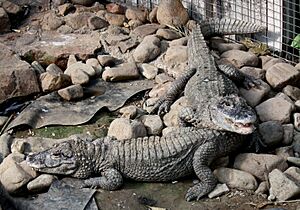
Lizards
- Chinese crocodile lizard
- Chinese water dragon
Turtles and tortoises
Snakes
- Sharp-nosed pit viper
- Dice snake
- Twin-spotted ratsnake
- Mamushi
- Grass snake
- Mountain pitviper
- Jerdon's pit viper
- Bamboo pit viper
- Mangshan pitviper
- Motuo bamboo pitviper
- Stejneger's pit viper
Amphibians
China has 346 species of amphibians, which is more than any other country in the Old World! While many are common, about 27.3% of amphibian species are extinct or threatened.
Frogs
True frogs (Ranidae)
- Amolops aniqiaoensis
- Amolops bellulus
- Amolops chunganensis
- Amolops gerbillus
- Amolops granulosus
- Amolops hainanensis
- Amolops jinjiangensis
- Amolops kangtingensis
- Amolops liangshanensis
- Amolops lifanensis
- Amolops loloensis
- Amolops mantzorum
- Amolops medogensis
- Amolops monticola
- Amolops ricketti
- Amolops torrentis
- Amolops viridimaculatus
- Amolops wuyiensis
- Chevron-spotted brown frog
- Eastern golden frog
- Emei music frog
- Huanren frog
- Imienpo Station frog
- Johns' groove-toed frog
- Korean brown frog
- Plateau brown frog
Dicroglossidae
- Chinese edible frog
- Concave-eared torrent frog
- Doichang frog
- Northern frog
- Kuhl's creek frog
Tree frogs
Microhylidae
- Boreal digging frog
- Painted chorus frog
Litter frogs
- Brachytarsophrys carinense
- Brachytarsophrys feae
- Brachytarsophrys popei
Shrub frogs (Rhacophoridae)
Salt water frogs
China is home to one of the few modern amphibians that can handle short trips into saltwater.
Toads
True toads (Bufo)
- Ailao toad
- Asiatic toad
- Korean water toad
Horned toads (Xenophrys)
- Convex-tailed horned toad
- Convex-vented horned toad
- Great piebald horned toad
- Jingdong horned toad
- Kuatun horned toad
- Mangshan horned toad
- Medog horned toad
- Mount Dawei horned toad
- Nankiang horned toad
- Boettger's horned toad
- Glandular horned toad
- Omei horned toad
- Spiny-fingered horned toad
- Wuliangshan horned toad
- Wushan horned toad
- Zhang's horned toad
Other toads
- Mongolian toad
- Oriental fire-bellied toad
- Rough-skinned horned toad
- Shaping horned toad
- Spiny-fingered horned toad
Salamanders and newts
- Amji's salamander
- Black knobby newt
- Central Asian salamander
- Chenggong fire belly newt
- Chiala mountain salamander
- Chinese giant salamander (Andrias davidianus)
- Chinese fire belly newt
- Chinese warty newt
- Chinhai spiny newt
- Chuxiong fire-bellied newt
- Siberian salamander
- Dayang newt
- Fischer's clawed salamander
- Fuding fire belly newt
- Guabang Shan salamander
- Guangxi warty newt
- Guizhou salamander
- Hainan knobby newt
- Hong Kong warty newt
- Jinfo Mountain salamander
- Korean salamander
- Kuankuoshui salamander
- Puxiong salamander
- Shuicheng salamander
- Spot-tailed warty newt
- Spotted paddle-tail newt
- Taliang knobby newt
- Wanggao warty newt
- Wenxian knobby newt
- Western Chinese mountain salamander
- Xingan salamander
- Yellow-spotted salamander
- Yiwu salamander
- Yunnan lake newt
- Zhijin warty newt
Caecilians
- Banna caecilian (Ichthyophis bannanicus)
Fish
China has over 1,000 freshwater fish species! The Yangtze River is the richest river basin, with over 350 unique freshwater fish. Many of these are found only in China and are seriously threatened. Sadly, some, like the Chinese paddlefish, may already be extinct. China also has many cavefish species.
With a long coastline, China has many marine fish species, such as the Pacific cod.
Invertebrates
Invertebrates are animals without backbones.
Freshwater crabs
China has over 250 different species of freshwater crabs, many of which are found nowhere else. This makes China the country with the most freshwater crab species!
Molluscs
Butterflies
Centipedes
Endangered species
For a full list of endangered and protected species in China, see List of endangered and protected species of China.
Images for kids
-
The giant panda is found only in China, where it is an endangered and protected species.




